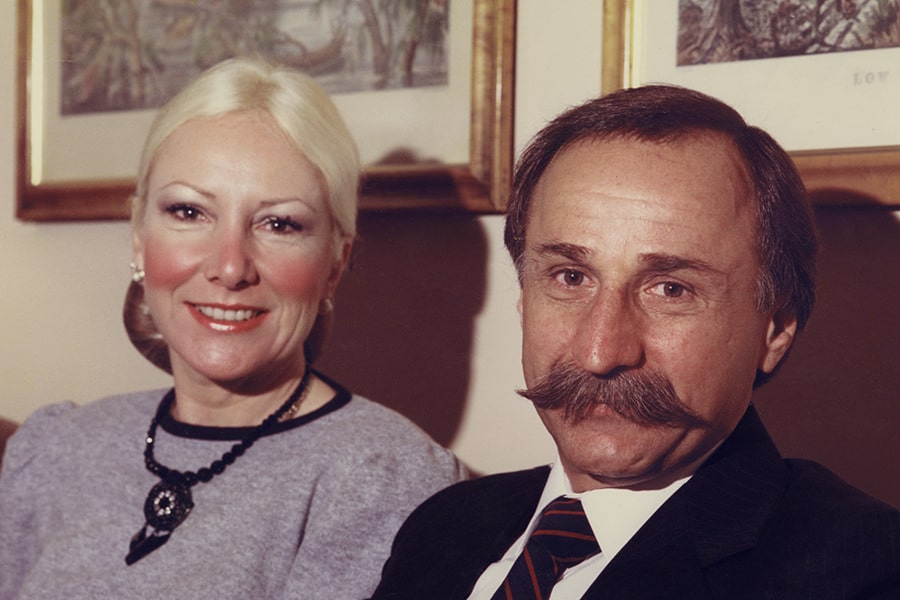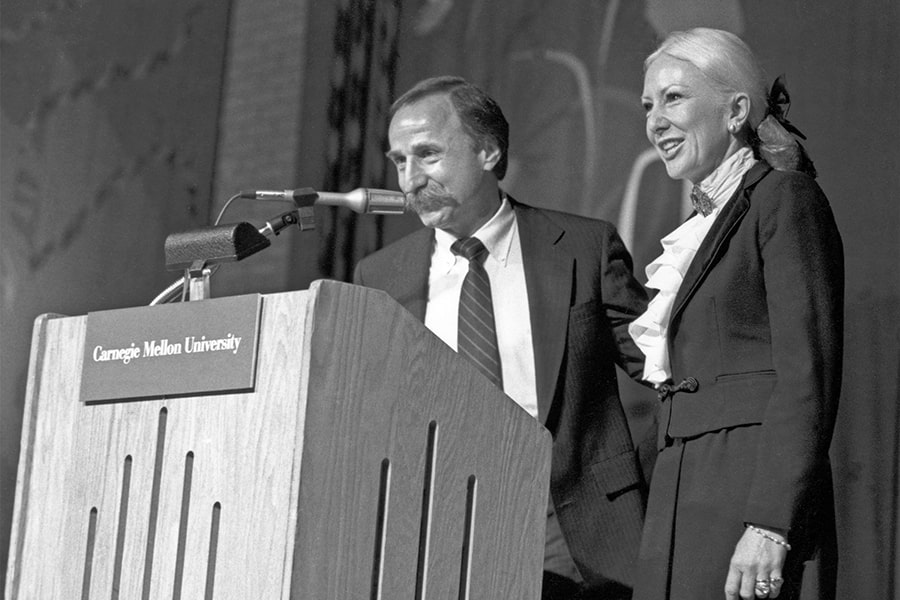CIC To Be Named For Former CMU President
By Teresa Thomas
 Six former Carnegie Mellon presidents have been immortalized with university buildings named in their honor. Soon there will be a seventh.
Six former Carnegie Mellon presidents have been immortalized with university buildings named in their honor. Soon there will be a seventh. Students, faculty and staff are invited to a ceremony at 11 a.m., Wednesday, April 18 in the Collaborative Innovation Center (CIC) lobby, where the CIC will be named the Robert Mehrabian Collaborative Innovation Center in honor of CMU's seventh president. Mehrabian, who led CMU from 1990 to 1997, is now chairman, president and CEO of Teledyne Technologies Inc.
The dedication recognizes Mehrabian's contributions to economic development in Pittsburgh and to technology commercialization at CMU. The building houses technology research and development offices for Apple, Intel and Disney. It also houses Carnegie Mellon's CREATE Lab - a robotics lab sponsored by Microsoft - and space for Carnegie Mellon CyLab, the university's Information Networking Institute and the CERT(r) Coordination Center, Carnegie Mellon's internationally known cybersecurity team.
Carnegie Mellon's eighth President, Jared L. Cohon, said the Collaborative Innovation Center was a particularly appropriate choice to honor Mehrabian's legacy to the university and to the region.
"During his presidency, Robert Mehrabian was an ardent and effective advocate for the role of Carnegie Mellon in generating prosperity for the city and the nation. It is fitting that his legacy be associated with a building that so visibly links the university, its students and faculty to leading technology companies and the broader Pittsburgh community.
"As an entrepreneur, a scientist and leader on this campus, he defined new relationships for Carnegie Mellon with many business and community partners and helped our Pittsburgh campus to grow gracefully and beneficially for its residents. It is an honor to attach the name of Robert Mehrabian to the Collaborative Innovation Center," Cohon said.
Legacy Includes Economic Development, Tech Transfer
Mehrabian played a vital role in the Regional Economic Revitalization Initiative, which in the 1990s developed a plan for economic development in the greater Pittsburgh area. Mehrabian also is credited with stimulating the university's technology transfer operation and his efforts helped lead to the development of a Carnegie Mellon facility in the Pittsburgh Technology Center, a former mill site that is now a vital stretch of research and development facilities along the Monongahela River.
Efforts like these eventually enabled university and government leaders to successfully obtain funding for the creation of the Collaborative Innovation Center, a unique business incubator that contributed to Pittsburgh being named a top technology city by Forbes.com.

Robert and Victoria Mehrabian during his presidency at CMU, which lasted from 1990-1997.
The facility, which received a Gold LEED rating from the U.S. Green Building Council for its sustainability and energy efficiency, was built in 2005 to provide office and lab space for technology companies wishing to partner with Carnegie Mellon to create innovative new concepts and products for the marketplace. Many call the building, developed in partnership with the Regional Industrial Development Corporation, a "hub" of technological innovation in Pittsburgh. It is the only building in the world to have housed Google, Intel, Apple and Disney.
Mehrabian helped to lay the groundwork for CMU's successful technology commercialization efforts. Over the years that followed, faculty and students created more than 300 companies and 9,000 jobs in the region. Building on the Mehrabian legacy, CMU announced earlier this year a Greenlighting Startups initiative, a portfolio of CMU incubator groups designed to speed innovation from the research lab to the marketplace.
Improving Undergraduate Education and Quality of Life on Campus
During his presidency, Carnegie Mellon continued to climb among the nation's elite universities, making great strides in improving undergraduate education and the quality of life on campus for students, faculty and staff. Enhancements in academic programs and student activities helped student applications soar to more than 13,000 in 1996, more than doubling the amount in Mehrabian's inaugural year in office.Mentoring and advising initiatives and efforts to enhance undergraduate teaching helped to attract high-quality students and greatly improved the student retention rate.
Mehrabian oversaw the completion of the East Campus Project, an ambitious building plan that resulted in a new University Center, two residence halls, Gesling Stadium and a multi-level indoor parking garage. The Intelligent Workplace, the Purnell Center for the Arts, and Posner Hall, also were completed as part of the East Campus Project.
A research facility at the Pittsburgh Technology Center and the George A. Roberts Engineering Hall also were completed during his tenure.
The Mehrabian File
Mehrabian, who holds bachelor's and doctor's degrees from MIT, spent nearly 30 years in academia, starting at MIT in 1968 and concluding as president of Carnegie Mellon in 1997. He left MIT in 1975 as an associate professor, and from 1975 to 1979 he was a professor of metallurgy and a professor of mechanical engineering at the University of Illinois at Urbana-Champaign. From 1983 to 1990, he served as dean of engineering at the University of California, Santa Barbara.

Robert and Victoria Mehrabian upon their arrival at CMU in 1990.
In 1999, Mehrabian became president and CEO of Teledyne Technologies Incorporated following its spin-off from Allegheny Technologies. He became chairman of the board in December 2000.
Mehrabian also spent four years in the Senior Executive Service of the U.S. government. As director of the Center for Materials Science of the Department of Commerce's National Institute of Standards and Technology, he initiated numerous government/industry programs that became models for such cooperative efforts.
During his UC Santa Barbara and Carnegie Mellon tenures, he spun-off a number of high technology companies. An internationally recognized authority on advanced technologies, Mehrabian served as senior adviser in manufacturing and high technology processes for many Fortune 500 companies.
Mehrabian holds eight U.S. and more than 40 foreign patents. He has authored 139 technical papers and edited six books in the field of materials science and engineering.
He has earned numerous honors and awards. A member of the National Academy of Engineering, he was named a fellow and distinguished Life Member of the American Society of Metals International (ASM), a fellow and Leadership Award recipient of the Minerals, Metals and Materials Society, and a winner of the ASM's Henry Marion Howe Medal.
He has received honorary doctorates from Carnegie Mellon and Chatham University.
Presidents in Perpetuity
Cyert Hall (Richard Cyert, president from 1972-90)Stever House (H. Guyford Stever, president from 1965-72)
Warner Hall (John Christian Warner, president from 1950-65)
Doherty Hall (Robert E. Doherty, president from 1936-50)
Baker Hall (Thomas S. Baker, president from 1922-35)
Hamerschlag Hall (Arthur A. Hamerschlag, president from 1903-22)
Naming Ceremony
11 a.m., Wednesday, April 18Collaborative Innovation Center lobby
Students, faculty and staff are invited to attend.
